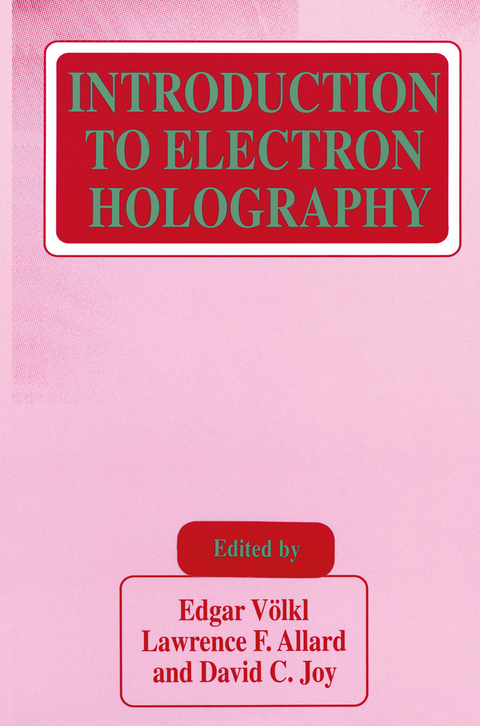
Introduction to Electron Holography
Springer-Verlag New York Inc.
978-1-4613-7183-0 (ISBN)
1 The History of the Electron Biprism.- 1 The beginning.- 2 The first interferometer.- 3 The biprism idea.- 4 Biprism design and 1st experiments.- 5 Further Tübingen experiments.- 2 Principles and Theory of Electron Holography.- 1 Introduction.- 2 Imaging theory.- 3 In-line point-projection holography.- 4 In-line TEM holography.- 5 Off-axis TEM holography.- 6 Off-axis holography in a STEM instrument.- 7 Theoretical formulations for other modes.- 8 Interference in diffraction patterns and holographic diffraction.- 9 Application to the study of magnetic and electric fields.- 10 Studies of surface structure.- 11 Discussion.- 3 Optical Characteristics of an Holography Electron Microscope.- 1 Introduction.- 2 Brightness.- 3 Coherence and contrast transfer.- 4 Illumination geometry.- 5 Isoplanatism and coma.- 6 Contrast transfer considerations in the field emission microscope.- 7 Standard criterion for microscopes for holography.- 8 Conclusion.- 4 Practical Electron Holography.- 1 Introduction.- 2 Setting up the instrument.- 3 Recording holograms.- 4 Important parameters.- 5 Further considerations.- 6 Conclusion.- 5 Quantitative Electron Holography.- 1 Introduction.- 2 Electron detectors.- 3 Characteristics of CCD cameras.- 4 Factors affecting detection limits.- 5 Applications of quantitative electron holography.- 6 The Reconstruction of Off-Axis Electron Holograms.- 1 Introduction.- 2 Basic reconstruction process.- 3 Minimizing the effects of sampling.- 4 Lens aberrations: Distortions.- 5 The reconstruction process using a reference hologram.- 6 Other reconstruction methods.- 7 Methods for lower carrier frequencies.- 8 Display of phase information.- 7 Electron Holography of Electromagnetic Fields.- 1 Introduction.- 2 Theory.- 3 Holographic electron microscope forsuperconductivity investigations.- 4 Observation of fluxons in superconductors.- 5 Lorentz observations.- 6 Higher resolution holography.- 7 Conclusions.- 8 On Recording, Processing And Interpretation Of Low Magnification Electron Holograms.- 1 Introduction.- 2 General considerations on the electron phase.- 3 Centering the sideband.- 4 Quantification of magnetic and electric fields.- 5 Distinguishing magnetic and electric fields.- 6 Dislocations in a hologram.- 9 High Resolution Off-Axis Electron Holography.- 1 Introduction.- 2 Wave optical imaging in HRTEM.- 3 Off-axis electron holography: Principle.- 4 Correction of aberrations.- 5 Optimizing the parameters for high resolution electron holography.- 6 Practical examples.- 7 Conclusion.- 10 Off-Axis Stem Holography.- 1 Introduction.- 2 Hologram formation and reconstruction schemes.- 3 Experimental considerations.- 4 Accuracy of phase measurement.- 5 Application of special detectors.- 6 Far-out-of-focus off-axis STEM holography: Application to magnetic materials.- 7 Optimum conditions for high resolution imaging.- 8 Correction of lens aberrations.- 9 Conclusions.- 11 Focus Variation Electron Holography.- 1 Introduction.- 2 Image formation in a TEM.- 3 Least squares wave function reconstruction.- 4 Experimental results.- 5 Interpreting the reconstructed object wave.- 6 Validity of the channelling theory.- 7 Scaling.- 8 Other aspects of channelling.- 9 Results.- 10 Conclusions.- 12 Applications of Electron Holography.- 1 Introduction.- 2 Mean inner potential and its effects on phase images.- 3 Theoretical calculations of mean inner potential.- 4 Holographic experimental measurements of mean inner potential.- 5 Specimen thickness and its effects on phase and amplitude images.- 6 Applications of off-axis electron holographyto studies of interfaces.- 7 Applications of holography to surfaces.- 8 Applications of holography to fine particles.- 9 Conclusions.- 13 Electron Holography Using Diffracted Electron Beams (DBH).- 1 Introduction.- 2 Basic theoretical considerations.- 3 Analysis of the interference phenomena.- 4 Influence of coherence.- 5 The holography mode.- 6 Experimental method.- 7 Spherical aberration.- 8 Material science applications.- 9 Interesting perspectives.- 10 Conclusions.- 11 Appendix.- 14 Electron Holography at Low Energy.- 1 Introduction.- 2 Electron ranges in solids.- 3 Image formation and reconstruction.- 4 Nanotips.- 5 Instruments.- 6 Radiation damage.- 7 The reflection mode.- 8 Conclusions.- 15 A Plus or Minus Sign in the Fourier Transform?.
| Zusatzinfo | 212 Illustrations, black and white; XVIII, 354 p. 212 illus. |
|---|---|
| Verlagsort | New York, NY |
| Sprache | englisch |
| Maße | 155 x 235 mm |
| Themenwelt | Naturwissenschaften ► Biologie ► Zoologie |
| Naturwissenschaften ► Chemie ► Analytische Chemie | |
| Naturwissenschaften ► Physik / Astronomie ► Festkörperphysik | |
| Technik ► Elektrotechnik / Energietechnik | |
| Technik ► Maschinenbau | |
| ISBN-10 | 1-4613-7183-X / 146137183X |
| ISBN-13 | 978-1-4613-7183-0 / 9781461371830 |
| Zustand | Neuware |
| Haben Sie eine Frage zum Produkt? |
aus dem Bereich


